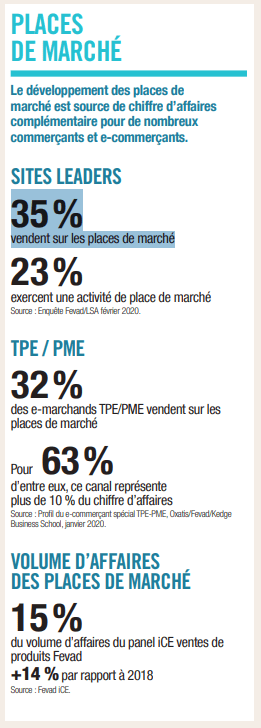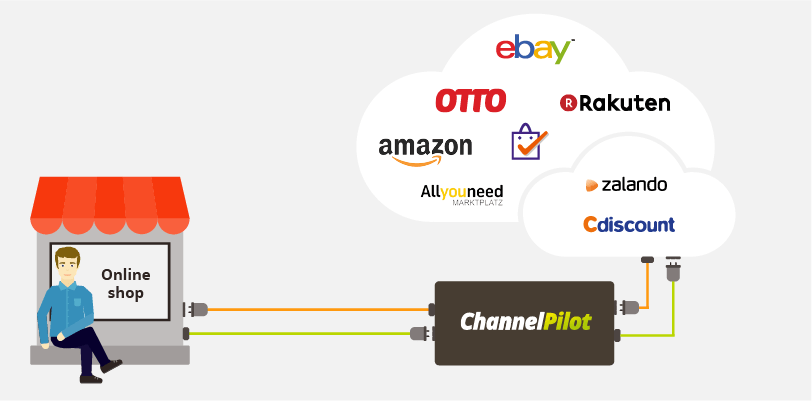Selling your products on a marketplace is an excellent way to make your brand more visible and get more product views. Buyers are attracted to these platforms because of the variety of products and the easy shopping experience. eBay, Cdiscount, Rakuten, Amazon etc. are examples of well-established marketplaces with a strong presence in terms of search engine positioning.
Marketplaces can be compared to shopping centres and e-merchants can be compared to shops housed in shopping arcades in commercial locations. You will be able to pursue a dual objective: increase your brand’s reputation and your turnover. So, how do you increase your sales on marketplaces?
Take advantage of the audiences provided by marketplaces
A marketplace is a platform that allows interaction between buyers and sellers in order to optimise commercial transactions. Like on Amazon, for example, the buyers and sellers are brought together in a commercial and technical environment, which is the marketplace, until the transaction is complete.
This “virtual shopping centre” therefore facilitates the sale for both the seller and the buyer, while ensuring the transaction takes place in the best possible conditions. What’s more, the transaction is covered by the platform, which acts as a trusted third-party in the event of a problem. The customer can return to the marketplace at any time to resolve the dispute involving the seller.
Top 5 most visited marketplaces in the UK
Marketplace sales made up 60% of the $2.86 trillion global ecommerce market in 2018, following 20% year-on-year growth.
- Amazon : 416.9M visitors
- eBay: 244.9M visitors
- Etsy: 19.4M visitors
- Wayfair: 16.3M visitors
- Wish : 7.4M visitors
Source : Online Marketplaces in the UK
5 good reasons to publish your catalogue on a marketplace
You must continue to make a sufficient margin in order to sell your products on marketplaces. If the commission applied by these marketplaces allows you to make a profit, don’t hesitate, go for it, there are many advantages:

1. Expand your brand’s reach and customer base
The biggest advantage of marketplaces is by far the possibility to expand your customer base. Since you take advantage of Amazon’s reputation to attract new customers nationally and internationally.
2. Gain the trust of your customers
By selling on a marketplace, you save all the marketing costs associated with acquiring new customers. In order to convert you must position yourself correctly in terms of the price and complete the information required by the marketplace(s). When consumers trust marketplaces, they trust you.
3. Get started quickly and easily
The marketplace’s customer service takes care of disputes if need be, a significant time saving for small businesses, but not just that. You will also save money on design, hosting, order processing, financial transactions and even delivery in some cases (note, the commission with Amazon for example is extremely high if you want their logistics service to handle the delivery).
4. Take advantage of integrated internationalisation
Most marketplaces distribute products internationally. So, when you start selling your products on a marketplace, you have the chance to export without the constraints associated with VAT, payment methods, delivery etc.
5. Access an additional sales channel
When you already have a strong brand or you simply want to make your name a little more widely known, marketplaces can be the ideal place to get people excited about your products and your brand.
Source : Webretailer, 2020
3 practical tips for selling better & selling more on marketplaces
Selling your products on a marketplace doesn’t guarantee instant success but gives you many solutions to optimise your ‘product’ catalogue. You must develop a marketing strategy to maintain your margins while working on your brand’s/products’ visibility.
Like any marketing initiative, you will need to be strategic in how you generate a presence on these platforms. With the above advantages in mind, let’s now look at how you can achieve this.
1. Optimise and advertise
Set yourself apart from the competition by providing your potential customers with as much information as possible. Start by optimising your ‘product’ pages in order to attract, inform and sell.
- Write simple and specific product descriptions (add technical information if needed)
- Create a descriptive and catchy title in keeping with the product offering
How do you create a catchy title?
Be specific and take a descriptive approach by providing as many characteristics as possible. Ask yourself what query your prospect could have typed in to find your product: ‘product name’ + ‘brand’ + size/age’. For example:
- ‘‘ORCHARD TOYS Farmyard Sticker Colouring Book – Educational Colouring Book – Colour and Write Farmyard Animals – 3 Years +’
- ‘BIC Kids Tropicolors 2 Colouring Pencils Assorted Colours, Cardboard Wallet of 12.’
- Include detailed, high quality photos and videos of your products
In addition to generating organic traffic to your products, you can also choose to advertise on the marketplace you use. This allows you to promote specific products, offers etc.
2. Focus on social proof: customer reviews and comments
Social proof is a key factor in the modern consumer’s decision to make a purchase (or not). Pay attention to communication with your customers, ensure you respect delivery times etc. in order to reap good reviews. These scores and comments are a guarantee of the quality of your products but also your services.
3. Ensure that the inventory, ordering and fulfilment line up
By working with marketplaces, you can have access to services that will help you maintain internal operations related to order fulfilment. For example, Fulfilment by Amazon (FBA) essentially takes care of the whole process, which allows you to focus on your product development and overall customer experience. Note, your margins must be high to cover the costs involved in this delivery process.
If you want to go further in managing your catalogue, a flow manager such as Channel Pilot Solution allows you to publish your catalogue on more than 2000 channels (marketplaces, price comparators etc.) and, among other things, adjust your offers automatically depending on your competitor’s prices.Regardless of the level of support you receive from a marketplace, it is imperative that your stock, orders and fulfilment processes remain consistent over time. As, if you sell your products on Amazon, your rating (as a merchant) will depend on your responsiveness and your effectiveness in solving problems.
Finally, keep an eye on your stock and make sure that your product is divided up correctly depending on the marketplaces you sell on the most. The last thing you want is for demand to increase without being able to ensure supply.
In conclusion: it’s all a question of balance
Publishing a product catalogue on a marketplace is a question of balance and control. You need to keep control of your catalogue, your content, monitor your stock, your prices and your product positioning in relation to the competition. It is by managing these metrics that you will be able to optimise your catalogue and improve your customers’ shopping experience. You need to keep monitoring your sales and margins even more so, when selling on a third-party platform!

0 Comments